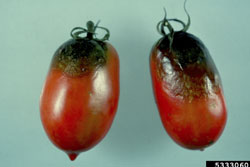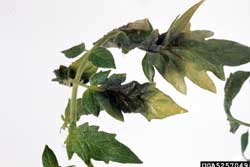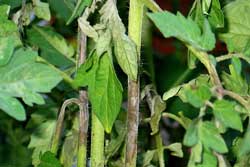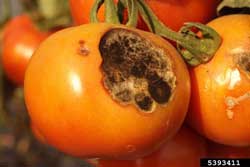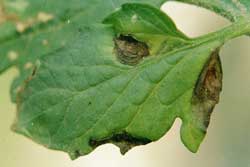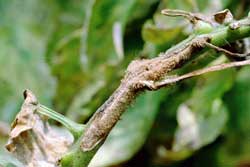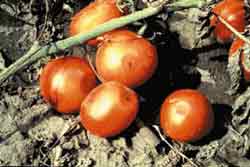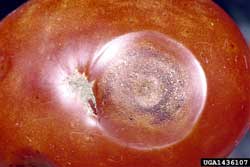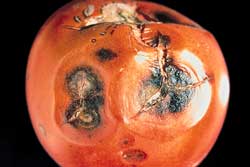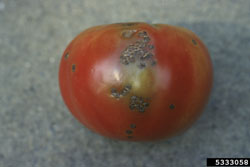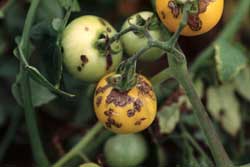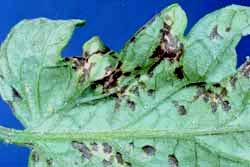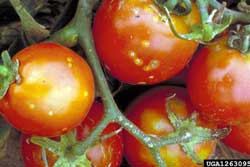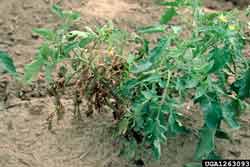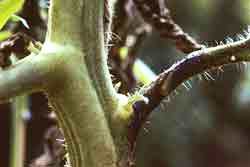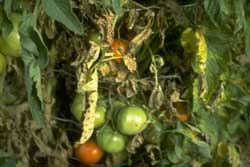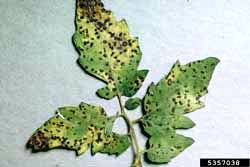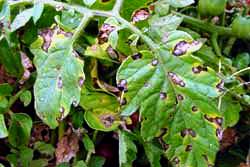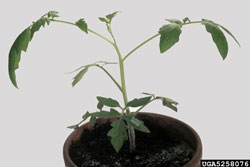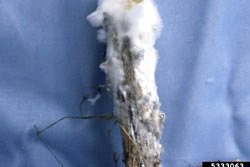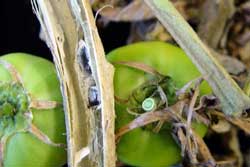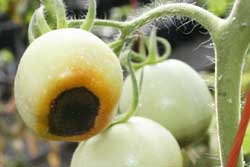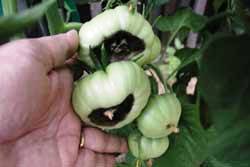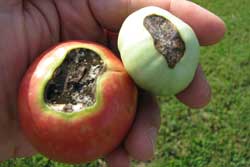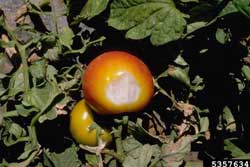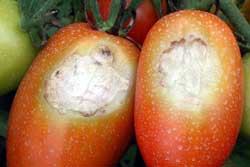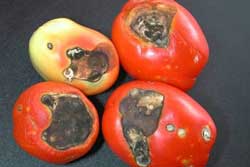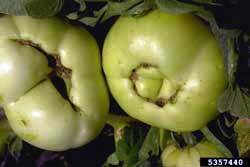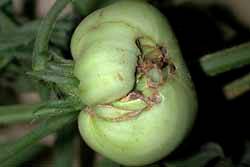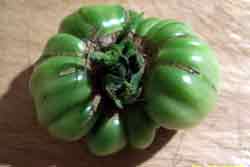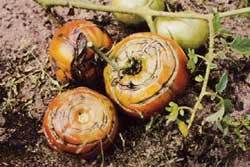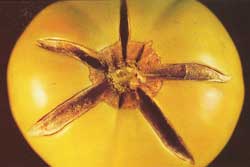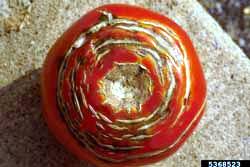Common Tomato Diseases and Disorders
Diseases
Late Blight—Phytophthora infestans
** Late Blight is a very serious disease. If you suspect Late Blight in your garden, please contact the University of Maine Cooperative Extension, Pest Management Office at 800-287-0279 **
Early Blight—Alternaria solani
Anthracnose—Colletotrichum coccodes
Bacterial Spot—Xanthomonas campestris
Bacterial Canker—Clavibacter michiganensis
Tomato Leaf Spot—Septoria lycopersici
White Mold (Sclerotinia stem rot)—Sclerotinia sclerotiorum
Physiological
Blossom End Rot
Sunscald
Catfacing
Fruit Cracking
Click on images to view full-size
Identification and Control Information
- Tomato Diseases and Disorders (includes information on most of those listed) [PDF]—Iowa State University Extension
- Tomato Leaf and Fruit Diseases and Disorders (includes information on many of those listed plus others) [PDF]—Kansas State University Cooperative Extension
- Recognizing Tomato Problems (PDF)—Colorado State University Extension
Late Blight
- Late Blight of Potato and Tomato: Resources and Alerts—University of Massachusetts Extension
- Late Blight on Tomato—Cornell University, Long Island Horticultural Research & Extension Center
- Late Blight Management for Fall, Winter and Spring (PDF)—University of Massachusetts Extension
- Gardening After Late Blight (PDF)—University of Maine Cooperative Extension
- Late Blight of Potato and Tomato (PDF)—Maryland Cooperative Extension
- Late Blight: A Serious Disease of Potatoes and Tomatoes (PDF)—Cornell University Cooperative Extension
- Information about Tomato Late Blight including Organic Products—North Carolina State University Cooperative Extension
- Fact Sheet with Symptoms and Management Strategies—Cornell University
- Managing Late Blight in Tomato and Potato–An Essential Part of Gardening (PDF)—Cornell University
- Late Blight: Frequently Asked Questions by Gardeners, Growers & Consumers (PDF)—Cornell University
Early Blight
- Tomato Disorders: Early Blight and Septoria Leaf Spot (PDF)—University of Wisconsin Extension
- Early Blight of Tomato (PDF)—University of Maine Cooperative Extension
- Early Blight of Tomatoes (PDF)—Virginia Cooperative Extension
- Early Blight on Tomatoes and Potatoes (PDF)—Florida Cooperative Extension Service
- Early Blight and Septoria Leaf Spot of Tomato (PDF)—Cornell University Cooperative Extension
Anthracnose
- Anthracnose of Tomatoes (PDF)—The Ohio State University Extension
- Anthracnose of Tomatoes (PDF)—AVRDC–The World Vegetable Center
Bacterial Spot and Bacterial Canker
- Bacterial Canker of Tomato (PDF)—University of Kentucky Cooperative Extension Service
Tomato Leaf Spot (Septoria)
- Septoria Leaf Spot of Tomato (PDF)—University of Maine Cooperative Extension
- Tomato Disorders: Early Blight and Septoria Leaf Spot (PDF)—University of Wisconsin Extension
- Early Blight and Septoria Leaf Spot of Tomato (PDF)—Cornell University Cooperative Extension
- Septoria Leaf Spot of Tomatoes (PDF)—The Ohio State University Extension
- Early Blight and Septoria Leaf Spot of Tomato (PDF)—Cornell University Cooperative Extension
White Mold
- Pest Management: White Mold of Vegetables (PDF)—University of Maine Cooperative Extension
Blossom End Rot
- Blossom-End Rot of Tomato, Pepper, and Eggplant (PDF)—The Ohio State University Extension
- Blossom End Rot of Tomatoes and Other Vegetables (PDF)—South Dakota State University Cooperative Extension Service
- Tomatoes: Blossom End Rot, Sunscald, Catfacing (PDF)—Oklahoma State University Cooperative Extension Service
- Plant Disease Control: Tomato Blossom-end Rot—Oregon State University Extension
Sunscald
- Tomato Disorders: Sunscald (PDF)—AVRDC–The World Vegetable Center
- Tomatoes: Blossom End Rot, Sunscald, Catfacing (PDF)—Oklahoma State University Cooperative Extension Service
Catfacing
- Catfacing (PDF)—AVRDC–The World Vegetable Center
- Tomatoes: Blossom End Rot, Sunscald, Catfacing (PDF)—Oklahoma State University Cooperative Extension Service
Didn't find what you were looking for? More Help with Disease Identification
Want to Know More? More Information About Healthy Gardens
[Photos, left to right: Robert Wick, University of Massachusetts, Bugwood.org; Division of Plant Industry Archive, Florida Department of Agriculture and Consumer Services, Bugwood.org; Department of Horticulture Website at Cornell University; Yuan-Min Shen, Taichung District Agricultural Research and Extension Station, Bugwood.org; Clemson University - USDA Cooperative Extension Slide Series, Bugwood.org; Clemson University - USDA Cooperative Extension Slide Series, Bugwood.org; USDA; Clemson University - USDA Cooperative Extension Slide Series, Bugwood.org; Apsnet.org; Mary Ann Hansen, Virginia Polytechnic Institute and State University, Bugwood.org; Ufl.edu; Clemson University - USDA Cooperative Extension Slide Series, Bugwood.org; Heinz USA Archive, Bugwood.org; Heinz USA Archive, Bugwood.org; UMass Extension; MU Extension Plant Diagnostic Clinic; William M. Brown Jr., Bugwood.org; ISU Plant Disease Clinic; Division of Plant Industry Archive, Florida Department of Agriculture and Consumer Services, Bugwood.org; Mary Ann Hansen, Virginia Polytechnic Institute and State University, Bugwood.org; Iowa State University Extension; Tim Coolong, University of Kentucky; Patrick Byers, MU Extension; Howard F. Schwartz, Colorado State University, Bugwood.org; Queen's Printer for Ontario, 2009; Queen's Printer for Ontario, 2009; M.E. Bartolo, Bugwood.org; Queen's Printer for Ontario, 2009; Univ of California Extension; Texas AgriLife Extension Service, Texas A&M System; Paul Bachi, University of Kentucky Research & Education Center, Bugwood.org ]
